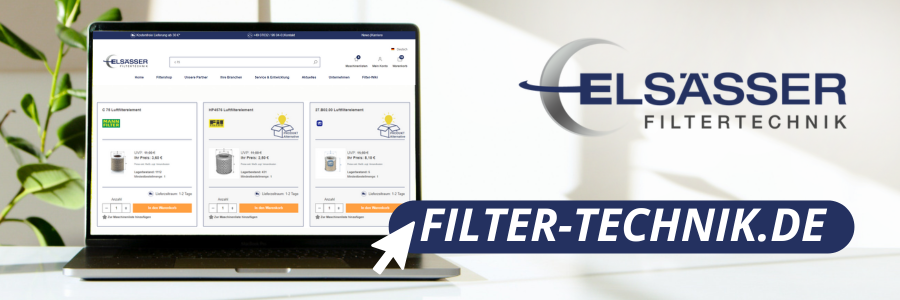Air-conditioning and ventilation filters
Air conditioning technology and ventilation filters at ELSÄSSER
Our extensive range of air conditioning and ventilation filters includes filter classes Coarse, ePM10, ePM2.5 and ePM1 in accordance with the applicable ISO standard 16890. EN1822 covers filter classes E10 to U17 for particulate filters and is characterised by safety, quality and environmentally friendly materials. See for yourself our excellent service, high quality and fast delivery times, and take advantage of our outstanding price/performance ratio.
Various types of filters with activated carbon are available for the adsorption of unwanted odours or gases from the air. We are your competent partner for individual solutions in this product area. Our air conditioning and ventilation filters are available with EuroVent certification. In addition to air conditioning and ventilation technology, we serve various industries such as manufacturing, food, pharmaceuticals and clean room technology with our range of filters.
Air as a foodstuff
We breathe in and out around 12,500 litres of air every day. The quality of this air affects our health, our performance and our well-being. Most people spend around 80-90% of their time indoors. That is why it is important to ensure that indoor air is good, clean and low in pollutants.
The World Health Organisation (WHO) estimates that around seven million people worldwide die each year as a result of air pollution. Breathing polluted air can pose a variety of health risks.
Where are the filters used?
Air filters are installed in all ventilation and air conditioning systems, both in public and commercial buildings as well as in industry. We cover 100% of these with our product range. Our filters are used wherever ventilation systems are used to create a comfortable indoor climate to protect people and their health.
Filter classes according to ISO 16890
The ISO 16890 filter standard fundamentally divides filter classes based on new filter classes (Coarse, ePM10, ePM2.5, ePM1). These are based on the particle size in the existing outside air in µm. For better comparison of the filters with each other, the separation efficiencies are given as a percentage after the respective new filter classes. The old filter classes from G3 to F9 are no longer applicable and may no longer be used.
Why does ISO 16890 exist?
The actual operating behaviour of an air filter in practice differs from the loading behaviour compared to the ASHRAE dust used in the EN 779 test, as this has nothing to do with the dust fractions present in the outside air. The filter evaluation in EN 779 was carried out exclusively for particle sizes of 0.4 µm. In order to obtain more realistic results on the efficiency of air filters, the separation efficiency of the air filters is carried out over 3 fine dust classes, namely PM10, PM2.5 and PM1. The entire particle spectrum from 0.3 µm to 10 µm is included.
How an air filter works
The way a filter works is generally the same regardless of its design. Particles are separated on the inlet side (= dirty side) and transported to the clean air side. Depending on the application, surface or depth filters are used. In the case of a classic bag filter, for example, the air to be cleaned flows through the bags from the inside to the outside. In many systems, filtration takes place across several filter stages. The first filter stage (pre-filter) catches coarse dust. This protects the highly effective fine filter in the second filter stage from excessive dust loading and contributes to improved service life.
For all filter types, such as bag, panel or compact filters, attention must be paid to the installation situation and the alignment. The air direction marking must be taken into account. It is also important to regularly check filters with seals for damage. This is the only way to ensure that the filter can be used to its full potential.














